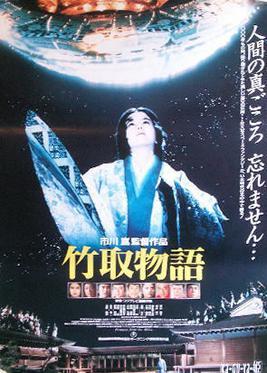In eighth-century Japan, a man (Toshiro Mifune) and his wife (Ayako Wakao) are mourning the death of their 5-year-old daughter, Kaya. They live beside a forest of bamboo, whose stalks the man cuts and turns into baskets and other artifacts, which he sells to make a living. One night they see a bright light and their hut is shaken by a huge tremor. The next morning, when the man goes out to investigate he finds near his daughter's grave a large egg-shaped object. It begins to crack open and as he watches, a baby crawls from it and begins to grow rapidly until it assumes the form of his dead child. The man and his wife raise the girl as their daughter, Kaya, and discover that the egg-shaped object from which she emerged is pure gold, so they become rich enough to move into a large house. Kaya swiftly grows into a young woman (Yasuko Sawaguchi) whose beauty attracts high-born suitors. But she has brought with her a small crystal ball that eventually reveals her secret: She is from the moon, the sole survivor when the ship that was carrying her crashed. To ward off her suitors, she proposes impossible tasks to win her hand. And then the ball reveals that at the next full moon, a ship will arrive to carry her home. The entire realm has fallen in love with Kaya, and on the night of the full moon, troops are stationed about the house to shoot down any arriving ships. Up to this point, Kon Ichikawa's Princess From the Moon has been a charmingly magical fantasy film, a smart adaptation of an ancient Japanese folktale, The Tale of the Bamboo Cutter, with beautiful sets by Shinobu Muraki, costumes by Emi Wada, and color cinematography by Setsuo Kobayashi. But suddenly Ichikawa imposes on the setting a spaceship out of Close Encounters of the Third Kind (Steven Spielberg, 1977), and Kaya is drawn up into it in flowing robes and accompanied by what appear to be glowing cherubs, an image that recalls Renaissance paintings of the Assumption of the Virgin Mary, like this one by Rubens:
It's a startling shift in tone and technique, to say the least, especially when compounded by the insertion of a pop song, "Stay With Me," by Peter Cetera behind the end credits. Critics, too, were jarred by the overlaying of a sci-fi trope on a traditional tale, but audiences seemed to like it. A somewhat more traditional version of the story, The Tale of the Princess Kagya (Isao Takahata), was produced by Studio Ghibli in 2013 and was nominated for the animated feature Oscar.
A blog formerly known as Bookishness / By Charles Matthews
"Dazzled by so many and such marvelous inventions, the people of Macondo ... became indignant over the living images that the prosperous merchant Bruno Crespi projected in the theater with the lion-head ticket windows, for a character who had died and was buried in one film and for whose misfortune tears had been shed would reappear alive and transformed into an Arab in the next one. The audience, who had paid two cents apiece to share the difficulties of the actors, would not tolerate that outlandish fraud and they broke up the seats. The mayor, at the urging of Bruno Crespi, explained in a proclamation that the cinema was a machine of illusions that did not merit the emotional outbursts of the audience. With that discouraging explanation many ... decided not to return to the movies, considering that they already had too many troubles of their own to weep over the acted-out misfortunes of imaginary beings."--Gabriel García Márquez, One Hundred Years of Solitude
Sunday, May 14, 2017
Princess From the Moon (Kon Ichikawa, 1987)
Links:
Ayako Wakao,
Emi Wada,
Kon Ichikawa,
Princess From the Moon,
Setsuo Kobayashi,
Shinobu Muraki,
Toshiro Mifune,
Yasuko Sawaguchi
Subscribe to:
Posts (Atom)

